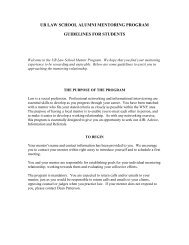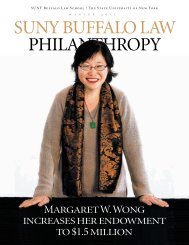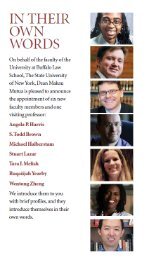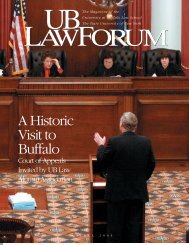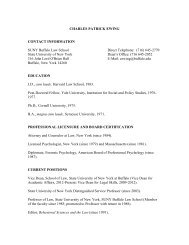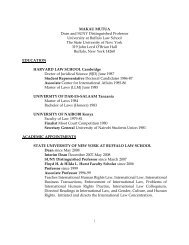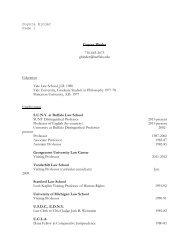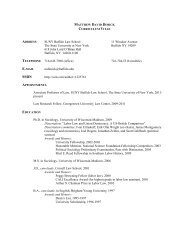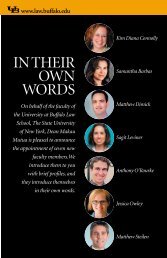0 Law cover 2010 (Page 203) - SUNY Buffalo Law School - University ...
0 Law cover 2010 (Page 203) - SUNY Buffalo Law School - University ...
0 Law cover 2010 (Page 203) - SUNY Buffalo Law School - University ...
You also want an ePaper? Increase the reach of your titles
YUMPU automatically turns print PDFs into web optimized ePapers that Google loves.
23<br />
information for all local redistrictings<br />
in New York State, in an Internet-accessible<br />
database.“A lot of people involved<br />
in the process aren’t aware of<br />
the rules,”Halberstam says.“The goal<br />
is to provide for each local redistricting<br />
the particular laws that apply there.<br />
“My hope is to create a mechanism<br />
of monitoring by disclosure.You let the<br />
local institutions do what they want to<br />
do, but you force them to provide information<br />
to a central organization.”Such<br />
a clearinghouse, he says, could identify<br />
a set of best-practices standards for local<br />
redistricting, then call out localities<br />
that fail to implement those practices –<br />
a watchdog function pushing lawmakers<br />
toward making the redistricting<br />
process fairer and more open to public<br />
scrutiny.<br />
In addition, the conference will feature<br />
a demonstration workshop of<br />
publicly available software that enables<br />
democracy advocates to challenge redistricting<br />
decisions based on demographic<br />
data. The workshop will be cosponsored<br />
by the <strong>Buffalo</strong> Partnership<br />
for the Public Good. Like all conference<br />
events, it is open to the public.<br />
The “Major Developments in Redistricting”conference<br />
is sponsored by the<br />
<strong>Law</strong> <strong>School</strong>’s Baldy Center for <strong>Law</strong> &<br />
Social Policy. Registration is required;<br />
e-mail BaldyRSVP@buffalo.edu.<br />
The conference Web site is<br />
linked off the Baldy Center site,<br />
www.law.buffalo.edu/baldycenter.<br />
A MODEST PROPOSAL<br />
Student and professor enter the fray<br />
over Erie County redistricting<br />
Astudent-professor collaboration<br />
that grew out of a <strong>Law</strong> <strong>School</strong><br />
seminar became part of the contentious<br />
discourse over redrawing the<br />
boundaries of Erie County’s legislative<br />
districts.<br />
A project by Patrick Fitzgerald ’11<br />
in Professor Michael Halberstam’s<br />
spring-semester <strong>Law</strong> and Democracy<br />
course,which focused on redistricting<br />
issues,“kind of evolved beyond what<br />
anybody could have imagined,”Fitzgerald<br />
says.Students in the course were required<br />
to develop a semester-long project,and<br />
Fitzgerald chose to take a hard<br />
look at Erie County legislative redistricting.The<br />
project grew,and in May<br />
he and Halberstam submitted an independent,non-partisan<br />
legislative redistricting<br />
plan to the Erie County Legislature<br />
and its Legislative Reapportionment<br />
Advisory Committee.The plan<br />
was developed in collaboration with<br />
the ACLU’s Voting Rights Project.<br />
The Erie County redistricting was a<br />
contentious and politically messy<br />
process.Voters had approved reducing<br />
the size of the legislature from 15 to 11<br />
seats,and two politically charged proposals<br />
for new maps failed to win approval<br />
in the County Legislature.The<br />
process culminated in a decision by<br />
U.S.District Court Judge William M.<br />
Skretny to impose his own redistricting<br />
map,saying he had to do so to ensure<br />
that potential candidates for the November<br />
election had time to collect the<br />
petition signatures they would need in<br />
order to be placed on the ballot.<br />
Fitzgerald’s and Halberstam’s map<br />
would have kept most towns and cities<br />
in single districts,except for Amherst<br />
and <strong>Buffalo</strong>,which are so big they must<br />
be divided between districts,and ensured<br />
that two of the three <strong>Buffalo</strong> districts<br />
would contain enough minority<br />
voters that they would be likely to elect<br />
a minority candidate.<br />
“Our map was consistent with<br />
keeping communities of interest together,”Fitzgerald<br />
says.“It also kept true<br />
to the principles of one person,one<br />
vote,in compliance with the Voting<br />
Rights Act,in majority-minority districts.Our<br />
plan was in the middle of<br />
two extreme proposals that were submitted.”<br />
Part of public-policy advocacy is<br />
getting the word out,and Fitzgerald<br />
and Halberstam made the<br />
case for their redistricting<br />
plan to newspaper reporters,on<br />
television and at<br />
news conferences.“It’s a<br />
very important part of<br />
public policy work,”Halberstam<br />
says.“You have to<br />
be part of the conversation.”<br />
Though Judge Skretny<br />
imposed his own map,it<br />
Patrick<br />
Fitzgerald ’11<br />
shares important characteristics with<br />
the UB proposal,such as the two majority-minority<br />
districts,drawn from<br />
east to west in the City of <strong>Buffalo</strong>,and<br />
an attempt to keep most towns and villages<br />
intact.<br />
For Fitzgerald,his senior seminar<br />
experience was an exciting capstone to<br />
his UB <strong>Law</strong> education. He particularly<br />
noted the time and attention his project<br />
received from a research-oriented professor<br />
at UB <strong>Law</strong> <strong>School</strong>.“We did a lot<br />
of work that was,I thought,an important<br />
learning experience for me,”<br />
Fitzgerald says.“Navigating a political<br />
process and trying to have something<br />
pass in Erie County,I can only imagine<br />
what it would be like nationally.It was<br />
definitely the best experience I had<br />
throughout <strong>Law</strong> <strong>School</strong>.”<br />
Adds Halberstam:“I really like the<br />
idea of combining theory and practice.<br />
This was something very concrete and<br />
practical we could do.It was a tremendous<br />
learning opportunity for Patrick,<br />
but also he brought so much expertise<br />
to the project.And it was good for the<br />
<strong>Law</strong> <strong>School</strong> as well,in that it shows the<br />
competency of our students and what<br />
they can do.”



